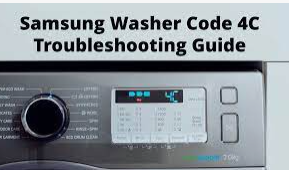How I fixed Samsung washing machine error 4C? Unlocking the mystery of Samsung Washer 4C Code
The Samsung Washer 4C error can be a perplexing issue, especially when water supply seems optimal. In this detailed guide, we delve into the intricacies of this error code, exploring the role of the pressure sensor and providing step-by-step solutions based on real-world experiences.
Understanding the Samsung 4C Error Code
When faced with the 4C error, the behavior of the washer can be distinctive. From incomplete water drainage to erratic water filling patterns, these symptoms point towards a malfunction in the pressure sensor.
A breakdown of the pressure sensor’s internal components, including a coil with variable inductance based on pressure changes. Learn about the sensor’s measurements and its range, shedding light on its calibration.

Initial Troubleshooting: Blowing Air into the Pressure Sensor Hose
Discover the first attempt at resolving the issue by blowing air into the pressure sensor hose. Uncover the potential blockages and why this step is crucial in restoring proper sensor calibration.
Virtual “Zero” Pressure Level and Sensor Calibration
Explore the impact of disconnecting the hose on the washer’s virtual “zero” pressure level. Understand the necessity of recalibrating the sensor by blowing air into the hose and preventing pressure escape during reconnection.
Extended Troubleshooting: Dealing with Recurring 4C Errors
An in-depth look at a recurring 4C error after an initial fix. Understand the shift in washer behavior and the revelation of a hole in the pressure sensor hose as a root cause.
Repairing the Pressure Sensor Hose
Step-by-step instructions on unscrewing the washer’s bottom plate to access and replace the pressure sensor hose. Practical tips on using durable alternatives and addressing potential leaks.
Advanced Diagnosis Tools
Introduction to advanced tools like a multimeter with frequency measurement. Learn how to utilize this tool for precise diagnostics, detecting air leakage, and interpreting frequency variations during wash cycles.
Preventive Measures and Maintenance Tips
Recommendations for preventing future issues with the pressure sensor hose. Insightful tips on using reinforced water hose for a long-lasting solution.
Fun Fact: Testing and Pumping Out Water
Discover a fun fact about the washer’s sensor behavior even when turned off. Learn how to use a multimeter, aquarium hose, and syringe for advanced testing and water pumping during diagnostic procedures.
Wrap up the guide with a summary of the troubleshooting steps, encouragement for readers to apply the solutions, and a wish for success in resolving the Samsung Washer 4C error.
Cleaning the Dispenser Drawer for Model WF50A8800AV
To maintain optimal performance and hygiene of your Samsung washer’s detergent drawer (applicable to Model WF50A8800AV), follow these detailed steps for a thorough cleaning process.
- Drawer Removal:
- Start by holding down the release lever on the inner part of the detergent drawer.
- Gently pull the drawer out to remove it from the washer.
- Lid Removal:
- Identify the pull tabs located near the back of the lid for both compartments.
- Utilize these tabs to remove the lids, ensuring complete access to the compartments.
- Interior Cleaning:
- Use a soft brush and warm water to clean the interior of both detergent compartments.
- Ensure thorough cleaning by reaching into corners and crevices.
- Wipe down the compartments with a dry towel after cleaning.
- Dissolving Detergent Residue:
- Address any detergent residue by pouring lukewarm water into both compartments.
- Scrub away residue using a soft brush and warm water, paying attention to stubborn areas.
- Repeat if necessary until all residue is dissolved.
- Drawer Recess Cleaning:
- Employ a soft brush to clean the drawer recess, ensuring no residue is left behind.
- Reach into corners and hidden areas to maintain a pristine drawer recess.
- Sealing Inspection:
- Before reinserting the drawer, ensure that the tops of both compartments form a snug seal around the lip.
- Proper sealing is crucial to prevent any leaks or spills during the washing cycle.
- Drawer Reinsertion:
- Carefully slide the cleaned and dried detergent drawer back into its place within the washer.
- Ensure it is securely and fully inserted to avoid any issues during operation.
- Final Drying Check:
- Confirm that the drawer recess is completely dry before reinserting it into your Samsung washer.
- This step prevents the accumulation of moisture, reducing the risk of mold or mildew growth.
By following these comprehensive steps, you ensure not only a clean detergent drawer but also contribute to the longevity and efficiency of your Samsung washer. Regular maintenance of this essential component enhances the overall performance of your appliance and provides a more hygienic laundry experience.





